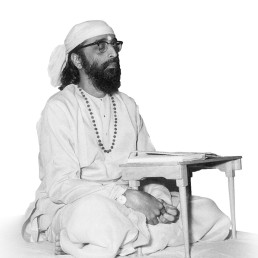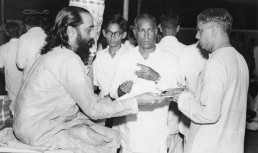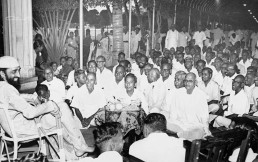
Jnana Yajna 66

Year & Dates:
February 07, 1960 to February 28, 1960

Yajna Topic:
Shrimad Bhagavad Gita- Chapter 2

Place:
Trichy (Tiruchirappalli), India
It was a spiritual windfall for the overjoyed seekers in Tiruchirappalli when Pujya Gurudev wrote indicating that He was available if a Gita Jnana Yajna could be arranged at short notice. This sudden fortune that came from the Guru Himself was because of the rare occurrence when a yajna planned elsewhere got canceled.The yajna committee in Trichy jumped into the preparations heart-first, and a huge Pandal stood ready in Thillai Nagar, the very place where Pujya Gurudev had spoken in His earlier Yajna in July 1959. The time was short to find a dignitary to inaugurate the 66th Jnana Yajna, Trichy. Again, the best outcome happened because Pujya Gurudev Himself inaugurated the yajna on Feb. 7, 1960, bringing greater happiness to the audience who welcomed His uninterrupted flow of thought from the opening minutes. The yajnashala was brimming as Pujya Gurudev transformed it into a Dharmakshetra.
Led by Shri Krishna and Adi Shankara
Tiruchirappalli basks in rich history, lyrical Tamil poetry, great philosophy, and a sacred aura because of its eminent temples. It was in the famous Sri Ranganatha Temple that the renowned poet Kamban first recited the celebrated Kamba Ramayanam, the immortal epic of Ramayana in Tamil.
Knowing Tiruchirappalli’s deep cultural heritage and having shared the knowledge of both Bhakti Yoga – chapter 12 and Purushottama Yoga – Chapter 15 in previous yajnas, Pujya Gurudev deemed that the audience was ready for the comprehensive essence of Gita’s chapter 2, the summative Sankhya Yoga. The beauty of chapter 2 of Srimad Bhagavad Gita is in how Bhagavan Krishna shakes Arjuna out of his stupor with the most profound essence of all Vedanta. Thus, chapter 2 encapsulates the entire breadth of teachings which are then expanded in the following sixteen chapters of the ever-relevant Gita. Pujya Gurudev, while strongly reminding the audience that Gita was universal and not parochial, brought out the importance of facing the world’s challenges with courage and conviction. He clarified that the Gita is not for escapists who claim that life is unreal like a svapna, a dream. Rather, dealing with life’s struggles as though life is svapnavat (dream-like), empowers one to live like a sthitaprajna (established in Truth).
The introspective collection of verses of Atma Bodha, an important preparatory text written by Shri Adi Shankara, was the focus in Pujya Gurudev’s morning discourses. As He introduced the fundamentals of the Advaita philosophy, Pujya Gurudev highlighted how the young Sri Sankara sparked a great revival of Sanatana Dharma at a time when the universal spiritual values were overshadowed by rampant ritualism and materialism. The Vedantic texts like Sri Shankara’s Atma Bodha awakened seekers to then grasp the unifying core of the upanishads for leading an integrated life.
It was a sublime 66th yajna where the audience were engrossed in Pujya Gurudev’s powerful exposition of both the sacred scriptural texts. Sweetening their intense contemplation with the sweet devotion to Bhagavan Krishna, the Laksharchana ceremony on February 21, 1960, was a devotional feast for the eyes and the heart. With gratitude, the Trichy audience recalled how it was in the 43rd Jnana Yajna at Trichy’s Golden Rock area that Pujya Gurudev had first incorporated the feature of such Laksharchana in His Jnana Yajnas.
Photo Gallery

“Think,” Says Pujya Gurudev
Thus, the Eternal Spirit in man asserting its false relationship with his body comes to feel bound by a thousand relationships with the world of things and beings among the outer objects. The same perfect Principle-in-life playing on the field of the mind comes to experience the imperfections of the emotional world as its own. The Divine-Spark-of-Life again, as it often does, assuming a false identity with the intellect, comes to sob and suffer for its hopes and desires, its ambitions and ideologies, which are the characteristic pre-occupations of the intellect.
The self thus getting reflected in the intellect, body and senses is the ego which is the victim of the world of objects, feelings and ideas. To this ego belongs all the sad destinies of life and the fleeting thrills of acquisition and possession. The ego it is, in Arjuna, that came to suffer its neurotic condition, goaded by its own delusions and its instinctive mis-apprehensions. Krishna knew in his Infinite Wisdom that mis-apprehension of Reality can take place only when it is preceded by a pitiable non-apprehension of Reality. Therefore, in order to cure the very source of Arjuna’s delusion, Krishna is here advising him the very cream of knowledge as declared in The immortal books of the Hindus, the Upanishads.
From Tyagi Magazine
Is Equanimity Possible?
Here is an excerpt from the teachings on Bhagavad Gita that uncovers the secrets of maintaining mental equanimity in the face of life’s challenges and desires. How does a man of wisdom attain the state of deep tranquility and learn practical techniques to cultivate inner peace in our own life.



